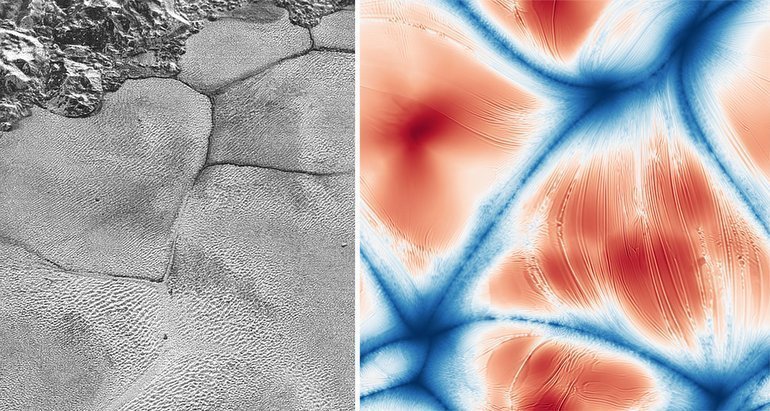It was unknown why fragments of the bright, heart-shaped plane of ice on the surface of Pluto, the Solar System’s largest dwarf planet, had such a striking angular shape. Now one model suggests that the sublimation of nitrogen ice could be the driving force behind this formation. According to the model, the evaporation of ice cools the surface, thus increasing the temperature difference towards warmer depths. This ensures heat dissipation and thus the awakening of fresh ice.
When NASA’s New Horizons spacecraft first passed near Pluto in 2015, it detected a surprisingly dynamic world of flowing glaciers, potential ice volcanoes, and possibly the once subglacial ocean. But particularly striking was the bright, heart-shaped plain of Sputnik Planitia. The surface of this region consists of about 30 kilometers of polygonal nitrogen ice blocks bordered by dark troughs. The nitrogen released from this region during the day is considered the engine of Pluto’s winds.
But how did the polygonal ice floes of Sputinik Planitia come about? And why do they have a regular, angular shape? In 2016, researchers concluded that this structure must have arisen by convection. There is a current circulating below the surface of the ice level, causing cold ice and warmer layers of ice to sink into the channel. This creates an almost regular, polygonal pattern of regions of rise and fall; just like on the surface of the sun. . . But this time only in slow motion and icy cold.

“We know that the extraordinary polygonal structures of the ice surface are formed by thermal convection of ice,” explains Adrien Morison of the University of Exeter. “But now the question arises as to how this process continues, because there is no adequate separation between surface and depth. It requires a temperature difference, and it’s doubtful whether Pluto’s interior can provide that.”
Morison and his team therefore looked for a different engine for heat convection – and they started on the surface of the ice, not at the depths. That’s because a temperature gradient can occur because heat is constantly being drawn from the ice from above. The researchers see sublimation as a possible actor: “We suspect that sublimation (the direct change of matter from solid to gas) is the mysterious engine that drives thermal transport to continue on Sputnik Planitia.”
Just as evaporation has a cooling effect on our skin or other surfaces, the direct transition from ice to gas has a cooling effect on the environment. Morison and colleagues used a model simulation to check whether this effect was sufficient to trigger a current circulating in the Pluto plane ice sheet, where they reconstructed conditions in the ice sheet of Sputnik Planitia.
The result confirmed the hypothesis: The cooling effect produced by the sublimation of nitrogen on the ice surface is strong enough to move the ice underground and maintain convection. This effect also resulted in the same polygonal structures as seen in Sputnik Planitita. The ice floes are therefore closely linked to Pluto’s climate and the expulsion of nitrogen ice.